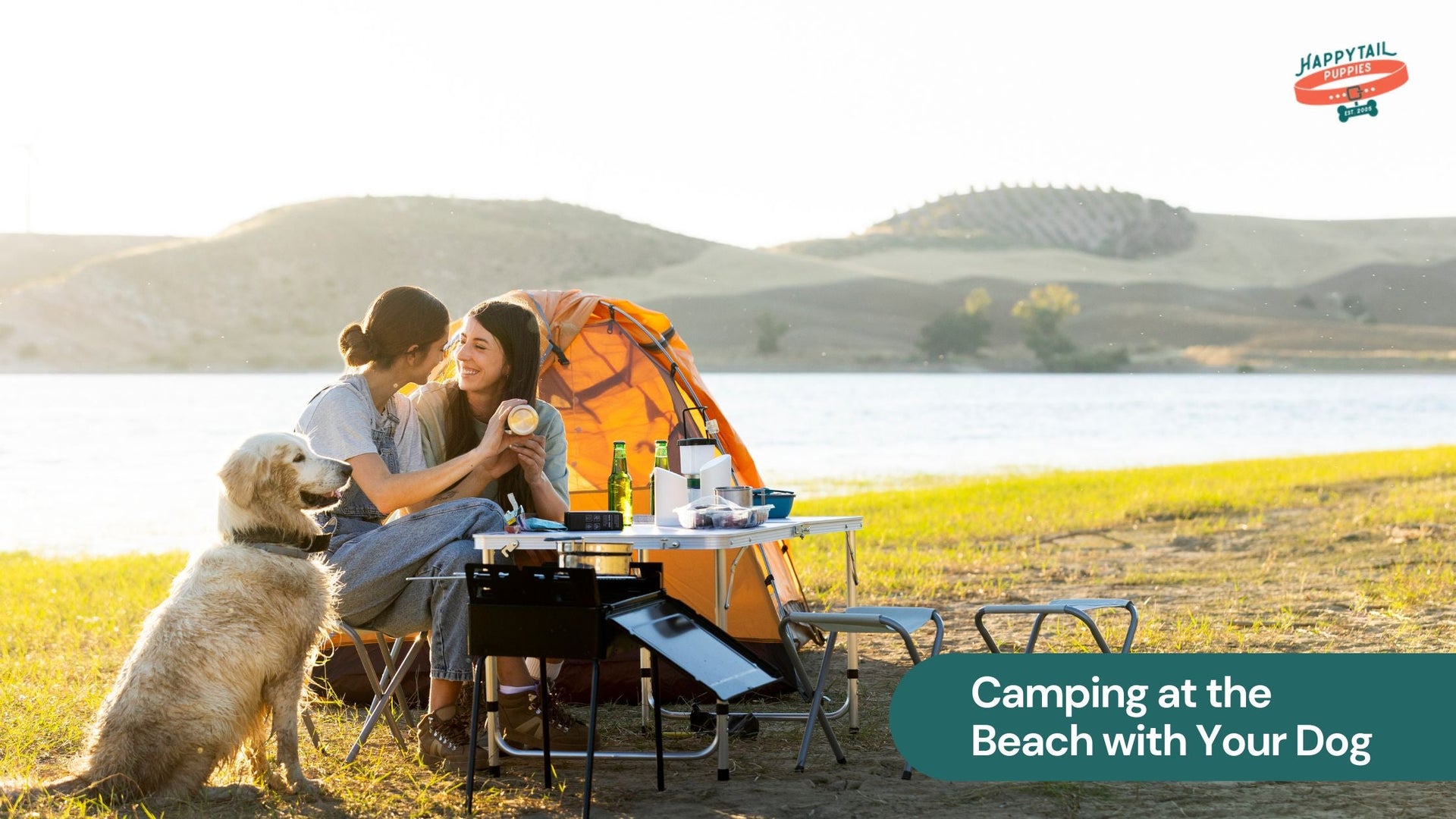Camping at the Beach with Your Dog: A Beginner’s Guide
Beach camping with your dog can be a truly special experience, fostering connection and outdoor exploration. However, careful planning is crucial to ensure safety, comfort, and a harmonious trip for both you and your furry friend. Learn how to prepare for saltwater, sand, heat, and unfamiliar surroundings, ensuring a memorable and responsible adventure.
Watching your pet at the shoreline, playing in the water, and relaxing with you when the sun goes down is truly special. Beach camping is peaceful and fun, and allows you to spend a lot of time exploring the outdoors. Caring for pets can be very rewarding for people who love them, as long as they use careful planning.
Many times, dogs require more than excitement to explore the beach safely. Not being prepared for the saltwater, sand, heat, and unfamiliar places can lead to big risks. A proper plan allows you and your pet to have fun and grow closer together. Choosing the right gear, selecting the best place for camping, and getting your mindset ready can make your beach camping with dogs truly memorable.
The Importance of a Thoughtful Approach to Beach Camping with Dogs
Any spontaneous trip may work out for a few adventurers; however, dog-friendly beach camping involves intention. Staying prepared is extremely important to ensure comfort, safety, and balance with the environment.
- Safety Is Non-Negotiable: Though sand may be difficult for dogs, beaches may bring sudden risks. Hidden dangers such as jellyfish, sharp shells, and shifting tides can cause problems. Consideration for your trip should include reviewing the tide, having a first aid set, and making certain your dog has plenty of shady rest and water.
- Comfort Enhances the Experience: Any discomfort your dog feels when traveling can quickly stress them out. For your pet, it’s most important that it has a cooling vest, a cozy place to relax, and plenty of fresh water to drink. Summer is a time when you must watch that your dog’s paws don’t get scratched on rough surfaces or burned by hot sand.
- Rules and Regulations Matter: Only some beaches can be used by dogs, and a handful require owners to keep their pets on a leash. Looking things up can prevent fines and embarrassing situations. You can check online websites for the best places to vacation with a dog in the US, offering key insights into the dog-friendly beach camping options.
- Wildlife Awareness Is Crucial: The coastal habitats are home to a delicate ecosystem and protected species. Allowing your dog to chase birds or dig near the dune disrupts the nesting grounds. National Park Service respects wildlife boundaries to safeguard the environment and your pet against harmful encounters.
- Good Pet Etiquette Preserves Access: Campsites and beaches lose their dog-friendly status due to repeated violations. Also, carry waste bags and dispose of them adequately if the trash bins are far from the camp.
- Planning Creates Peace of Mind: Preparation is no longer about gear; it even involves mindset. Whenever you are clear about your expectations, you reduce anxiety for you and your pup. A strategically planned beach trip with your dog, especially with a small dog breed like a Cavapoo, will allow more time for connection, exploration, and relaxation without worrying about things you might have already forgotten.
Tips to Plan the Perfect Beach Camping Trip with Your Dog
If you plan well, your dog will be safe, at ease, and comfortable during your visit to the beach. These tips can make everything easier, help you anticipate surprises, and make your trip memorable for you and your pet.
Choosing the Right Dog-Friendly Beach Campsite
Canines are welcome on every beach if you travel during the peak seasons. Check what nearby ordinances and local leash, dog zone, and time limits apply. An online search will show you choices for dog-friendly retreats that come with extras like agility areas, pet shower spots, and play zones where dogs can stay secure. Florida, California, and North Carolina all have state parks where you can camp with your dog on the beach.
Many dog-friendly beach camping areas feature dog waste stations nearby, safe play areas, and clean water. Make sure the parts of the yard with trees nearby or walls and fences are big enough for your dog. It's better to make camping reservations in advance during the summer because many people are looking for pet-accessible places at this time.
Preparing Your Dog for a Beach Camping Experience
It is important to train your dog before the trip to ensure that it behaves appropriately around wildlife, people, and other dogs. Reinforcing commands like "come," "stay," and "leave it" proves effective. These are vital for the situations where your pet encounters washed-up marine life, unfamiliar dogs, or sharp shells.
It is extremely important to adjust your dog to beach textures like crashing waves, hot sands, and the sounds of seabirds. Short practice trips to sandy parks or local beaches help your dog become more comfortable with the environment before making any longer stays.
If your dog is heading out camping with you for the first time, consider running a test in a nearby park or your backyard. This is effective for small dog breeds like Morkie, which are sensitive to new environments and nighttime noises. A positive introduction to nighttime noises or tent sleeping can reduce anxiety and help them sleep better once they are right at the coast. Early preparation can lay the best foundation for a safe and enjoyable dog-friendly beach camping experience.
Packing Essentials for Beach Camping with Your Dog
Success generally lies in the details, mainly in the gear. In addition to the basics of food, water, and poop bags, consider the items typically designed for windy or sandy conditions.
- A dog sleeping mat or bed
- Collapsible water bowls
- Canine sunscreen
- Life vest
- Portable shade or beach umbrella
- Tick/flea preventative treatment
A study by the American Kennel Club states that dogs are prone to heatstroke on beaches due to the reflecting sand surfaces and direct sunlight. Equip your campsite with multiple cooling methods that encourage hydration throughout the day.
Setting Up a Safe Campsite for Your Dog
Location is the real consideration. Avoid camping way too close to the tide line with the rising water that compromises the stability of the tent or the safety of your dog. Select a flat or a shaded area, inspecting it for sharp shells, trash, or glass that can harm their paws.
Secure a tie-out cable or stake down a long lead that offers the dog some freedom while keeping them safely within your camp boundaries. Ensure that the water bowls stay full and are placed in the shaded zone. Use a mesh enclosure or a dog walker for added containment and comfort. To prepare your dog for a long trip, introduce your dog to the setup gradually, allow them to explore the space, and reward them for their calm behavior. This can reduce stress and teach them that the campsite is safe and a familiar place.
Managing Food, Water, and Health on the Beach
The secret is to use clean water for your pets. Don’t let your dog drink saltwater, as it might make them sick or cause them to get dehydrated. Your dog should always have access to plain drinking water. Don’t cook inside your tent, as it may attract wildlife nearby. Storing food in closed containers can help prevent ants, seabirds, and raccoons from finding your food. If your pet is working out a lot, carry a few extra portions just in case.
It’s a good idea to have a pet first-aid kit close at hand. Booties, antiseptic wipes, gauze, and vet-approved pain relievers should be a part of your pet’s first aid kit. Rinse your dog’s paws under the tap and check often, since sand can cause some irritation. The American Veterinary Medical Association reports that being outside for a long period, often on beach sand, can raise a dog’s risk of heatstroke and sunburn.
Dealing with Wildlife and Environmental Risks
Curiosity in dogs can get them into trouble with wild animals. Seabirds that nest on beaches may become upset if you come too close, and touching or stepping on jellyfish and crabs can be hazardous.
Train your dog to stay away from objects or animals it doesn’t know. Walking at night? Remember to take a flashlight and keep looking for possible threats around you. Pick out beaches where there aren’t many wild animals if you want to camp with your dog at the beach.
Properly dispose of dog waste. Carry waste bags and use dedicated trash bins. Many parks fine those who don’t dispose of their litter properly, saving nature from pollution.
Activities to Enjoy with Your Dog While Camping
At the beach, you and your pet have a wide variety of things to do. You might try fetching with toys that float, a version of tug-of-war at the beach, or feeling the urge to dig in a fenced sandbox.
Wander along the coastline at times when there’s a beautiful sunrise or sunset. Lots of dogs, after a walk in the ocean, head to the shallow tide pools or prefer soaking in the sun beside their owners. If you’d like to take your dog kayaking, pick a spot where guides are available or rentals are allowed, and make sure they have jackets for dogs, too.
Taking photos of your trips lets you remember what happened and reminds you to save each step your puppy takes. Take phone cases or cameras that can be submerged, so you don’t have to worry about taking photos while on the water.
Nighttime Routines and Tent Sleeping Tips
Once it’s evening, having a set routine helps your dog relax. Spend your last few minutes before bedtime walking your pet in order to drain her extra energy and give her a chance to go outside. Keep a small flashlight or headlamp available for visibility.
Assign your pet a consistent sleeping spot inside the tent. Use familiar bedding or blankets from home for comfort. Dogs feel more secure surrounded by familiar smells. Feed your pet some time before bed, as food or emotion can disrupt normal digestion.
Add soothing sounds to your environment to suppress annoyances caused by noise. Certain owners like to have their dogs sleep safely in a crate inside the tent. Evaluate your dog’s preferences before finalizing your setup.
Emergency Planning and Local Veterinary Resources
Unexpected situations can arise. Never leave home without your pet’s medical records, vaccination history, and the contacts for your local vet. Study which 24-hour vet clinics are close to where you plan to stay at the beach.
Prepare a list with the numbers for animal shelters, park rangers, and poison control centers. If you don’t keep an eye on them, dogs may swallow something dangerous like algae or litter. How early you receive help often decides whether the response will be fast.
Leaving No Trace: Responsible Camping with Dogs
A clean and tidy spot is kind to nature and gives others a chance to stay there too. Remember to take everything you carry with you back out, including dog droppings.
In some beach parks, environment officials check every day and fine those who break the regulations. By following the local rules, you help dog owners enjoy time on the beach and make the place safer for everyone. Make sure your dog does not start digging up the ground, start chasing animals, or bother your yard’s plants. Valuing the natural systems around the community helps everyone and saves attractive coastal places for future use.
Conclusion
Beach camping with your dog offers the ideal chance to bond, unwind, and enjoy nature from a fresh perspective. Every breeze, wave, and sunrise becomes a cherished memory whenever you prepare thoughtfully and consider your dog's safety and comfort first. Dog-friendly beach camping becomes more than just a trip; it is a tradition that you wish to repeat year after year with smart choices and a bit of planning.


